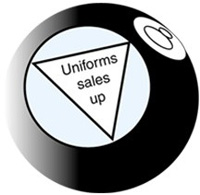|
2001 brought great uncertainty to America. From the beginning, nobody could agree whether the economy was heading for recession or if it already was in recession. The point at which everyone expected the economy to recover kept getting postponed from early second quarter to the third quarter to the end of the year. Even today in early 2002, experts differ in opinion on such matters as whether the economy has hit bottom and when the economy will grow again.
More importantly, after terrorists attacked both the World Trade Center and the Pentagon on Sept. 11, killing thousands of Americans, many people felt their whole world had turned upside down. Business came to a halt as people shared news with friends and family, trying to make sense of what happened and find a way to help repair the damage and cope with the loss.
The unrest continued. Anthrax mailings made people fear their mail. Several false starts on the road to economic recovery added bewilderment about the near future.
All of these events affected the uniform industry. To shed a little light on what to expect in 2002 MADE TO MEASURE asked several uniform leaders to share their thoughts on the direction this industry is heading. While it seems anything is possible, these insights help clarify what could lay ahead this year.
The next 12 months, 24 months, five years
Steven Robinson, vice president of Liberty Uniform, acknowledges that it’s impossible to make a bold statement about the entire uniform market because it serves many different industries, each having a unique set of circumstances. Despite our current national crisis, he predicts business will continue to expand because America’s population continues to rise.
“Although no one is sure where the post-Sept. 11 world is going, uniform sales will continue to grow, especially as they relate to security,” says Bill Wedekind, president of VF Workwear. Growth is more dependent on new job creation and a rebounding economy than anything a manufacturer or distributor can do. Another trend Wedekind has noticed is the merging of the “have to wear” uniform market, and the “want to wear” promotional products market. He says, “Uniforms are more than functional in today’s marketplace. More than ever, a company’s image includes uniforms (along with advertising and product positioning) in determining how the public perceives them.”
Eric Rubin, president of Blue Generation, sees the industry growing as uniforms play a more important role in identifying employees. For security reasons, it is very important to identify not only who’s an employee, but also their position, such as who’s in charge.
Executive Apparel president Donald Singer believes the growing optimism in the stock market signals significant opportunities in the uniform industry. In addition, the need for enhanced security in our country in the private and government sectors will spur the need for visibly, uniformed employees. “In the longer term, the industry will continue to grow moderately in an increasingly competitive environment, following the ready-to-wear model. This will lead to broad changes in traditional strategies, products and policies.”
One sector experiencing low growth is the medical uniform industry, currently at less than 2 percent growth annually. Rob West, vice president of Crest Uniform, a division of Aramark Corporation, says, “In the next 24 months to five years, it is going to become increasingly difficult for smaller manufacturers to grow in an industry with such nominal growth. Manufacturers will be taxed with identifying line extension opportunities and continually seeking means to take cost off their systems. The proliferation of discount retailers like Wal-Mart, K-Mart, Target and Kohl’s will continue to put pressure on our customers, the uniform retailers and cataloguers.”
Quentin Roberts, vice president of sales and marketing for G.A.L.S. of California, sees marginal growth in the healthcare market over the next 12 months, largely due to the economy. After that, this market will steadily expand to address the needs of additional healthcare workers hired to care for an aging population.
Larry Johnson, vice president of sales and marketing for Johnson’s Jewelry, predicts the overall market will decline four percent over the next twelve months and remain flat in 2003, but sees 10 percent growth coming in the next five years.
The most promising opportunities
Despite estimates of slower growth and consolidation, there are some sectors that hold some hope for expansion. Wedekind envisions security as a targeted growth area in the coming months. In addition to traditional security garments, industrial and image garments that help the public know who belongs in a particular place will increase. Wedekind cites delivery services, store personnel and all types of residential services as examples.
Rubin finds growing opportunities in the business sector because it gives individuals a way to feel part of the organization. He also sees growth in industries that benefit most from “new innovations in treatments that protect fabrics, making the garment’s life longer.”
Another opportunity is for uniform dealers to take back market share from the large manufacturers who sell direct to end users, according to Karen Gerson, co-president of Seventh Avenue Trade Apparel. “The local dealer could easily penetrate the hospitality market with products from a broad spectrum of manufacturers, many of which are very price-competitive and offer supremely high-quality products. Buyers like dealing with neighbors and supporting the community, and the dealer who is active in the community and offers hands-on attention becomes the most attractive choice.”
West sees opportunity for manufacturers seeking out ways to help their customers grow their businesses by adapting to change. “In the healthcare industry, more and more employees face the burden of paying for their own uniforms. This shifts the industry toward ready-to-wear. Innovation in the areas of fabrication and styling grow in
importance.”
Existing markets offer some strong possibilities too. Robinson says, “It’s far less
expensive to survey your current customers, find their needs and develop new products to service those needs than it is to develop entirely new markets.”
On the other hand, Roberts realizes the best way for everyone in the industry to grow depends less on competing for the same customers and more on finding businesses and institutions that would benefit from establishing a uniform program. As an example, Roberts illustrates that more unions and parents’ groups are calling for a required uniform program for cafeteria workers in their school districts. Tapping into new markets expands the universe of uniform buyers, creating a larger market for everyone.
Johnson projects increasing sales for all identification products, including insignia. ID products promote security and reassure a more nervous public.
The biggest challenges facing the industry
The biggest challenge for uniforms in geeral, according to Wedekind, is the value that consumers place on uniforms. He wonders if businesses will purchase uniforms when economic times are tough, particularly in slumping industries such as manufacturing, where the risk of going out of business may eliminate a company’s budget for uniforms.
Wedekind urges the dealer to “invest in the sales and marketing side of his business. A dealer cannot wait for someone to call him. Industrial laundries and ASI houses are aggressively seeking new business and adding sales people.”
The manufacturer’s biggest challenge remains maintaining profit margins as costs escalate when more customers insist on highly constructed, custom garments, according to Wedekind.
Gerson names another big challenge in the hospitality industry: With people afraid to travel, airlines, hotels and restaurants have less money to spend on uniforms.
Singer says, “I feel the biggest challenge facing the industry as a whole is the preservation of our image as a specialized market. Number one, this involves maintenance of our industry organizations, which must continue to survive, thrive and find ways to keep the industry exclusive. Secondly, with end-user budgets tightening, the natural tendency is to lose business to distributor networks from outside of our industry.” These distributors will undersell us because of inferior products and service, according to Singer. “In the long run, this can be disruptive to our interests and the interests of our end customers. We must find substantive ways to provide the end customer with real value without sacrificing the quality and service that makes our segment of the market unique.”
Another concern of Singer is the trend of manufacturers to bypass the distribution network to sell direct to end users. “There must be a partnership between dealers and those manufacturers that remain loyal to the network. This can only succeed if our dealers are provided with competitive pricing and quality services. On the other hand, the partner manufacturers must be provided with consistently increasing sales volume. All parties must work harder in order to help the dealer/distributor succeed in the challenging years ahead.
The long-term success of dealers/distributors depends on all parties working harder to provide high quality and more innovative products, according to Singer. “Manufacturers, large and small, have been handed a mandate to provide innovative services for our dealers and end users. Such things as user friendly, truly helpful Internet sites and creative marketing strategies are examples of possible services that our customers will make use of in the future.”
West finds two significant challenges facing the uniform manufacturer. “The first is the low growth rate of the industry overall. The second is the shifting sands of off-shore labor costs and duty/quota implications associated with pacts like NAFTA [North American Free Trade Agreement] and the AGOA [African Growth and Opportunity Act].”
An additional concern brought up by Roberts is the erosion of the dress code over the years, which makes it harder to convince buyers of the need for a more professional appearance. He urges dealers to get out of the store and make sales calls. “Those who wait for customers to come in the front door are going to be left at the church. Reaching out for customers is a must in today’s economy.”
In agreement with Roberts, Johnson goes further to explain, “A lot of businesses are putting new projects on hold until the economy gets better. We are getting new accounts, but it requires lots of ‘scratching.’ From 1995 to early 2000, we did not need to cold call. Now we make them every day.”
Despite these challenges, nobody’s throwing in the towel. Everyone’s rising to the occasion by making better products. Wedekind champions VF Workwear’s Horizon Technologies. “This is a proprietary 100 percent spun polyester from Milliken that takes comfort and durability to new levels. Horizon Technologies delivers superior moisture management, excellent soil release, soil redepositing prevention, unparalleled color retention, a soft and natural hand engineered for performance and an extended garment life.”
Gerson extols Seventh Avenue Trade Apparel’s solution for dealers looking to reduce inventory without sacrificing potential sales. “Our patented housekeeping line utilizes multi-sizing features to offer excellent inventory control.”
Blue Generation’s ServiceWear line is treated with Teflon fabric protector for stain resistance and easy care. Rubin says it has also expanded the line to include “twill shirts in long- and short-sleeves as well as pique shirts with and without pockets. All are available in men’s small to 6XL and ladies small to 3XL in 13 matching colors.”
Dealers wishing to break into larger, more customized programs can turn to Executive Apparel’s creative services. “We can provide complete, innovative program design, pattern development, sampling, presentation art and marketing services at competitive pricing,” says Singer. “Tapping into Executive Apparel’s 67 years of uniform manufacturing experience will allow dealers to compete effectively with many of the larger players inside and outside of the industry.”
West says, “At Crest, we are very excited about the increasing attention being placed on softer fabrics and cottons. Additionally, we are poised to leverage the marketing strength of our parent corporation, Aramark, to help our customers increase their own sales and profits.”
Pat Walsh, president of KTP Design Company, says, “We’ve gotten a tremendous reaction to our line of all-over printed knit shirts and woven camp shirts printed with the client’s own design. And now that we’ve lowered our minimum order to 200 shirts, we expect this business to explode for us.”
Even with this expert advice, there likely will be just as many surprises ahead for 2002 as there are in any year. Even more important than knowing what to expect is being able to adapt to the changes. “Anticipating change before it happens or at least recognizing it as it is happening is a common challenge facing every business regardless of size or industry,” says Robinson. “We have all had the experience of seeing the child of a friend after three, five or 10 years and remarking, ‘Oh, how you’ve grown.’ Business is no different. The key to success is to anticipate change or at the very least recognize it as it is happening and react quickly.”
|













